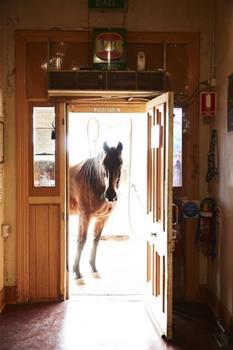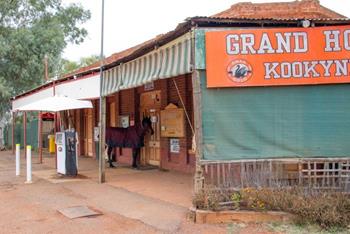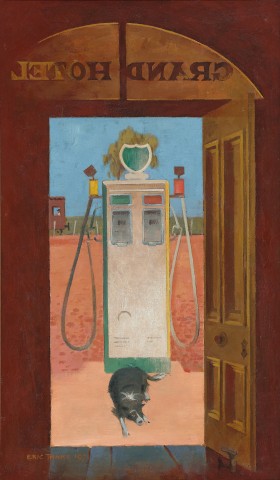THE WEEKLY TRAIN DEPARTS, THE DOG GOES BACK TO SLEEP, 1971
ERIC THAKE
oil on canvas
61.5 x 36.0 cm
signed and dated lower left: ERIC THAKE 1971
inscribed with title on backing board verso: “The weekly train departs, the dog goes back to sleep” / Grand Hotel / Kookynie. W. A
The artist
Thence by descent
Mrs Joan Mann and Mrs Jenifer Beaty, the artist's daughters (inscribed verso)
Tolarno Galleries, Melbourne
The National Australia Bank Art Collection, acquired from the above in 1979 (label attached verso)
Eric Thake, Geelong Art Gallery, Victoria, 15 October – 28 November 1976, cat. 19 (illus. in exhibition catalogue)
Eric Thake, Macquarie Galleries, Sydney, 2 – 14 February 1977, cat. 7
The Seventies: Australian Paintings and Tapestries from the Collection of National Australia Bank, National Gallery of Victoria, Melbourne, 15 October – 28 November 1982
The Seventies: Australian Paintings and Tapestries from the Collection of National Australia Bank, Geelong Art Gallery, Victoria, 30 April - 29 May 1988
The Seventies Exhibition: Selected Paintings from the National Australia Bank Collection, MacLaurin Hall, The University of Sydney, Sydney, 6 September - 1 October 1989, cat. 35
'The Seventies' Exhibition: Selected Paintings from the National Australia Bank Collection 'Modern Art of the Seventies', Caulfield Arts Complex, Melbourne, 18 January - 11 February 1990, cat. 22
Paint on the Tracks: Australian Artists and the Railway, S. H. Ervin Gallery, The National Trust of Australia, Sydney, 22 April – 29 May 1994, cat. 50 (illus. in exhibition catalogue, p. 11)
Best in Show – Dogs in Australian Art, Orange Regional Art Gallery, New South Wales, 9 April – 3 July 2016
Lindsay, R., The Seventies: Australian Paintings and Tapestries from the Collection of National Australia Bank, The National Bank of Australasia, Melbourne, 1982, pl. 91, p. 104 (illus.)
Best Loved Poems and Stories of the Australian People, Weldon Publishing, Sydney, 1988 (illus.)
Fry, G., 'Paint on the tracks: Australian Arts and the Railway', Look, Sydney, 1994, p. 20
Miller, S., Dogs in Australian Art, Wakefield Press, Adelaide, 2012, pp. 56, 57 (illus.), 213
210756.jpg

Eric Thake holds a unique place in the account of Australian Surrealism. It is a movement where visualisations of nightmares and apocalyptic trauma are common. Thake was never drawn to corporeal distortion and bloodlust, rather his inimitable observation and inventive imagination become his mainstay. ‘It was not until 1970 that I realised a long looked-forward visit to the old goldfields … most of them now but a name on a map, but I found a great deal of inspiration … for instance the filter on the right shoulder of the pump at the Grand Hotel attracted my attention to the possibility of a painting – if it had not been into
He was possibly Australia’s most unusual war artist – seemingly avoiding his brief and getting away with it. Bombings, soldiers fighting, wounded, the bloodied and bandaged were never his subjects. Thake preferred to anthropomorphise the debris of war giving objects such as Liberator’s face, 1945, the nose of a dismembered aircraft, an unexpected iconographic form. This offers a central clue to his future paintings.1
Following evening classes at the National Gallery Drawing School, Melbourne under Bernard Hall and W B McInnes, he joined George Bell’s classes part-time from 1925. He was taken by Bell’s interest in modernism and his encouragement of abstract principles, strong design and experimentation in composition. In the 1930s, he became aware of the English surrealists, especially Paul Nash, and Giorgio de Chirico’s metaphysical paintings. The culmination of these interests and the synthesising of their approaches was the work Salvation from the evils of earthly existence, 1940. It entered the collection of the National Gallery of Victoria a year after it was painted.2
Thake always took a sketchbook and camera with him. These not only served as a visual aide-mémoire but also, subjects such as Bushranger 1957 – a photograph of a wrapped petrol station pump – becomes a work in its own right.3 Thake’s linocuts are greatly admired for their wit and colloquial satire drawn from unexpected encounters.
In The weekly train departs, the dog goes back to sleep we see Thake’s quirky temperament brilliantly underplayed. In 1971 when he visited the West Australian Goldfields its heady days had long gone. Kookynie is a two-hour drive north east of Kalgoorlie and from a population of 3,500 its peak at the end of the nineteenth century its most recent count is fewer than 30 people.
210756 (2).jpg

Thake always takes us further than first impressions. There is an hot eerie stillness in The weekly train departs… It is not simply an evocative moment of nostalgia: a (then) modern petrol stand is front and centre. It alludes to some kind of unexplained certainty despite the haunting absence of people. The viewpoint of the artist in a standoff with his subject is all we are given. And the dog couldn’t care less. Or as Steven Miller as describes it, ‘the petrol pump… appears to have metamorphosed into a woman: in 1971, women were not permitted in the public bars of Australian hotels, but this one is clearly unstoppable.5
1. Liberator’s face, August 1945, gouache on paper, collection of the Australian War Memorial, Canberra
2. Salvation from the evils of earthly existence, 1940, oil on card, collection of the National Gallery of Victoria, Melbourne
3. Bushranger, 1957, silver gelatin photograph, collection of the National Gallery of Victoria, Melbourne
4. Artist’s quote, Lindsay, R., The Seventies: Australian paintings and tapestries from the collection of the National Bank of Australia, National Bank of Australasia, Melbourne, 1982, p. 104
5. Miller, S., Dogs in Australian Art, Wakefield Press, Adelaide, 2012, p. 56
DOUG HALL AM
